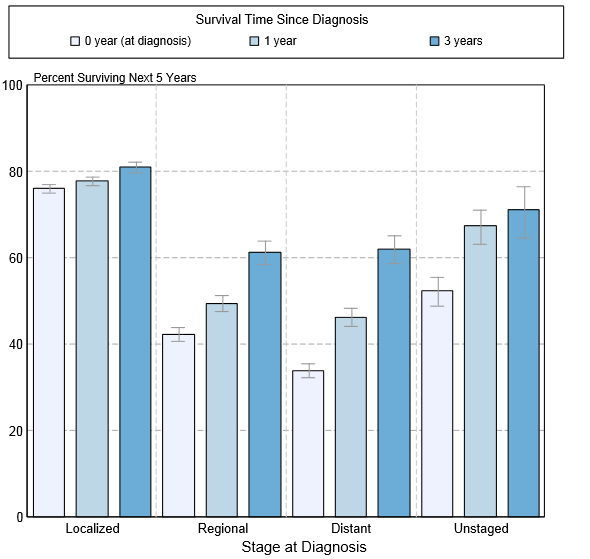Laryngeal cancer natural history, complications and prognosis
|
Laryngeal cancer Microchapters |
|
Diagnosis |
|---|
|
Treatment |
|
Case Studies |
|
Laryngeal cancer natural history, complications and prognosis On the Web |
|
American Roentgen Ray Society Images of Laryngeal cancer natural history, complications and prognosis |
|
FDA on Laryngeal cancer natural history, complications and prognosis |
|
CDC on Laryngeal cancer natural history, complications and prognosis |
|
Laryngeal cancer natural history, complications and prognosis in the news |
|
Blogs on Laryngeal cancer natural history, complications and prognosis |
|
Risk calculators and risk factors for Laryngeal cancer natural history, complications and prognosis |
Editor-In-Chief: C. Michael Gibson, M.S., M.D. [1] Associate Editor(s)-in-Chief: Rim Halaby, M.D. [2], Faizan Sheraz, M.D. [3]
Overview
If left untreated, laryngeal cancer produces few symptoms early in the course. Once the tumor has expanded from its site of origin, it may obstruct the airway. Common complications of laryngeal cancer include airway obstruction, neck disfigurement, and speaking difficulties. The prognosis varies with the type and stage of laryngeal cancer. Stage 4 squamous cell carcinoma of larynx has the most unfavorable prognosis.
Natural history
The natural history of laryngeal cancer varies with the anatomic site of origin. Supraglottic tumors are usually more aggressive in direct extension into the preepiglottic space and lymph node metastasis. The higher incidence of lymphatic spread has to do with the embryologic origin of the region. The supraglottis is derived from midline buccapharyngeal primordium and brachial arches 3 and 4 which have rich bilateral lymphatics. This is in contrast to the glottis which forms from midline fusion of lateral tracheobronchial primordium and arches 4, 5, and 6; here there is a paucity of lymphatics hence glottic cancers have less regional lymphatic spread. In supraglottic carcinomas one third to one half will have lymph node involvement. These lymph channels drain into the internal jugular chain. Direct extension can also occur into the lateral hypopharynx, glossoepiglottic fold and the tongue base. Glottic carcinomas are usually well differentiated, grow slow, and tend to metastasize late in their course. Due to embryonic reasons mentioned earlier glottic tumors typically metastasize after they have directly invaded adjacent structures with better drainage. These tumors do have early extension toward the anterior third of the vocal cord and the anterior commissure with subsequent spread to the opposite cord or anteriorly invade the thyroid cartilage. This thyroid cartilage invasion may be noted clinically as broadening of the thyroid cartilage. Glottic cancer can also extend superiorly into the ventricular walls or inferiorly into the subglottic space. These tumors can also cause cord fixation, as mentioned previously, owing more often to direct extension than nerve involvement but may be due only to shear bulk of the tumor. True subglottic carcinomas are uncommon, but can more often be seen in extension from glottic carcinoma which is a sign of poor prognosis. The lymphatic drainage patterns from this area increases the incidence of having bilateral disease and can lead to extension into the mediastinum. Accordingly glottic tumors with subglottic extension require, in addition to a total laryngectomy with ipsilateral thyroidectomy, an extensive lymph node dissection including the superior mediastinal nodes. This rich nodal spread is also thought to play a role in the high stomal reoccurrence after a total laryngectomy.
- If left untreated, laryngeal cancer produces few symptoms early in the course.
- Once the tumor has expanded from its site of origin, it may obstruct the aerodigestive passages.
Complications
Common complications of laryngeal cancer include:
- Airway obstruction
- Disfigurement of the neck or face
- Loss of voice and speaking difficulties
- Metastasis
- A small percentage of patients (5%) will not be able to swallow and will need to be fed through a feeding tube
Prognosis
Laryngeal cancers can be cured in 90% of patients if detected early. If the cancer has spread to surrounding tissues or lymph nodes in the neck, 50 - 60% of patients can be cured. If the cancer has metastasized to parts of the body outside the head and neck, the cancer is not curable and treatment is aimed at prolonging and improving quality of life. After treatment, patients generally need therapy to help with speech and swallowing.
5-Year Survival
- Between 2004 and 2010, the 5-year relative survival of patients with laryngeal cancer was 62.6%.[1]
- When stratified by age, the 5-year relative survival of patients with laryngeal cancer was 61.5% and 58.2% for patients <65 and ≥ 65 years of age respectively.[1]
- The survival of patients with laryngeal cancer varies with the stage of the disease. Shown below is a table depicting the 5-year relative survival by the stage of laryngeal cancer:[1]
| Stage | 5-year relative survival (%), (2004-2010) |
| All stages | 60% |
| Localized | 75.1% |
| Regional | 43.4% |
| Distant | 35.1% |
| Unstaged | 55.7% |
- Shown below is an image depicting the 5-year conditional relative survival (probability of surviving in the next 5-years given the cohort has already survived 0, 1, 3 years) between 1998 and 2010 of laryngeal cancer by stage at diagnosis according to SEER. These graphs are adapted from SEER: The Surveillance, Epidemiology, and End Results Program of the National Cancer Institute.[1]
References
- ↑ 1.0 1.1 1.2 1.3 Howlader N, Noone AM, Krapcho M, Garshell J, Miller D, Altekruse SF, Kosary CL, Yu M, Ruhl J, Tatalovich Z,Mariotto A, Lewis DR, Chen HS, Feuer EJ, Cronin KA (eds). SEER Cancer Statistics Review, 1975-2011, National Cancer Institute. Bethesda, MD, http://seer.cancer.gov/csr/1975_2011/, based on November 2013 SEER data submission, posted to the SEER web site, April 2014.
